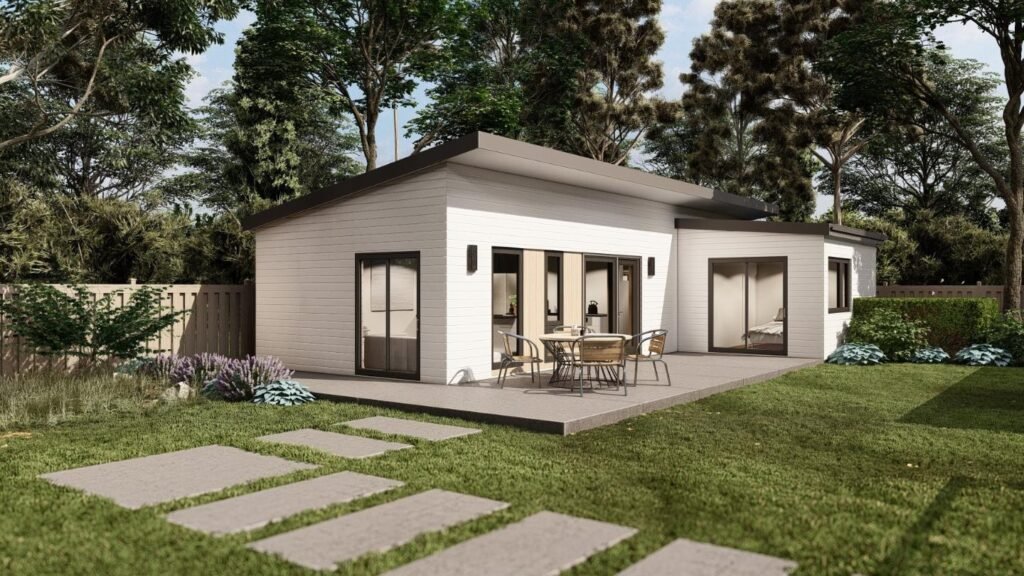You’ve poured your heart into your home, creating a haven that reflects your style and meets your needs. But what happens when your needs begin to outgrow your current living space? Many homeowners face this predicament, leading them to consider two options: building an ADU vs a home addition in Eugene, Oregon.
It’s a choice that can feel overwhelming. After all, it’s not just about adding square footage—it’s about creating spaces that enhance your lifestyle. Dissecting the intricacies of each option empowers you to make a decision that seamlessly blends your vision with your practical needs.
An In-Depth Look at ADU vs Home Addition
Let’s break down those acronyms, ADU vs home addition, and clarify what each term means. An ADU, or Accessory Dwelling Unit, is like a miniature home within your property, complete with a living area, kitchen, bathroom, and independent entrance.
Think of it as a self-contained haven for aging parents, boomerang kids, or even as a source of rental income. This contrasts with a home addition, which expands the footprint of your existing house.
Whether you crave a larger kitchen, a sun-soaked sunroom, or another bedroom for your growing family, a home addition merges seamlessly into the existing structure.
Purpose and Functionality
Think of your home improvement as an answer to a question: “What problem am I trying to solve?” When considering an ADU vs a home addition, the purpose dictates which one takes center stage.
ADU
Imagine your in-laws are finding it increasingly difficult to navigate their two-story home. Bringing them under your roof, but giving them their own space with a separate dwelling, sounds appealing. Or perhaps your college graduate is back home and wants to start their career but desires their own living space.
The need for independence is where ADUs shine. These self-contained units, tucked neatly on your property, offer the perfect blend of closeness and privacy. An ADU also gives you the flexibility to host friends and extended family or even generate extra income by renting it out.
Addition
Picture this: It’s family game night, and the laughter spills from every corner of your home. A home addition creates a larger communal space where these memories are made. The focus is on expanding shared spaces or creating dedicated areas for everyone, but all under the roof of the main house.
Maybe you’ve always yearned for a home office that’s tucked away from the activity of the main house. Perhaps you envision a playroom echoing with the joyous shrieks of your kids. You might even want windowless room additions to have a space free from distractions for your hobbies. In these situations, an addition can make even the busiest house feel more spacious and organized.
ADU vs Home Addition: Cost Considerations
Undeniably, embarking on any home renovation requires careful financial planning. Understanding the costs associated with both options will save you headaches. Let’s dive into a comparative breakdown of the costs.
ADU: The Frugal Choice?
Building an ADU often involves making the most of existing structures and connections, leading to potential cost savings. Converting a garage into a charming granny flat might be less costly than building a full-fledged addition with new foundations and roofing.
Remember that ADU costs can still climb if you are thinking bigger, say, a detached, ground-up unit.
Addition: Investment with Big Impact
Think of building a home addition as investing in a value-added extension of your house. Due to the scope of construction, home additions generally demand a higher financial commitment. The cost will also depend on factors like labor, materials, structural modifications, permits, and architectural fees.
Before you write off additions entirely, keep in mind that this substantial investment also yields the potential for significant appreciation of your property value.
Zoning and Permits: The Unsung Players in Home Expansion
It’s easy to get swept up in the excitement of reimagined living spaces. However, the feasibility of your vision often hinges on zoning ordinances and building codes, which determine what you can or cannot build. Navigate these regulations strategically, ensuring your dream project gets the green light from local authorities.
ADU: Navigating the Fine Print
Local ordinances related to ADUs can vary dramatically, influencing everything from height restrictions to parking requirements. Working with experienced professionals well-versed in local regulations and the legal considerations is paramount. This transforms what seems like a complex web of rules into a manageable roadmap.
Addition: Treading Familiar Terrain (But Still with Rules.)
While home additions usually face fewer restrictions compared to ADUs, seeking approvals and understanding the local building codes in your area remains non-negotiable. A clear understanding of the process helps anticipate challenges, keeping your project running smoothly.
Property Value: Turning Square Footage Into Equity
The decision to renovate should always consider the impact on the home’s overall value. An upgrade isn’t just about living but potentially increasing your returns in the long run. Both ADUs and home additions can increase your home’s value.
ADU: Your Secret Weapon for Added Value
Imagine transforming unused space on your property into a stylish ADU that caters to the demands of the housing market. An ADU is incredibly attractive, especially in urban areas or neighborhoods where housing is at a premium. The appeal for buyers is the allure of added flexibility – rental income, a private suite for family members – an ADU offers it all, increasing your property’s value significantly.
Addition: Creating the Forever Home for Buyers
A well-executed addition has the power to check off numerous boxes on a potential buyer’s wish list. Think of adding that coveted fourth bedroom, a luxurious master suite, or an updated kitchen. Additions can make your property more appealing, potentially boosting your asking price in the future.
Beyond Square Footage: Advantages of ADUs
ADUs present homeowners with distinct advantages that can elevate their property beyond just adding space. Let’s explore what sets them apart.
A Boon for Multigenerational Families and Evolving Dynamics
ADUs have become a cornerstone for fostering familial connections, particularly for multigenerational families seeking independent living while still living on the same property. As dynamics evolve, ADUs seamlessly transform to offer flexible solutions without compromising independence. This is especially important when children return home after college or when elderly parents need care.
It allows families to adapt without the upheaval of moving, ensuring loved ones are close without feeling cramped. For example, you could convert a detached garage into an ADU to provide a separate living space.
Sustainable Living and Reduced Environmental Impact
In an increasingly eco-conscious world, ADUs align with the desire to lessen our carbon footprint. Utilizing existing infrastructure translates to less waste, promoting sustainable practices without compromising on lifestyle enhancements.
Expanding Affordable Housing Options
In cities grappling with affordable housing shortages, ADUs can play a transformative role by injecting vibrancy into communities and providing alternative options without the sprawl associated with traditional housing development. This helps retain the unique character of neighborhoods while creating diverse living options.
The Allure of a Well-Planned Home Addition

Despite the flexibility of ADUs, a thoughtfully executed home addition offers benefits you can only achieve by adding onto your home.
Crafting Your Customized Oasis: A Symphony of Style
With a home addition, you control every element to match your unique taste, allowing for cohesive design, whether that’s extending architectural features for visual harmony or selecting materials echoing the home’s current style. Seamless integration of your vision is the hallmark of a well-executed addition, reflecting your individual preferences, down to the smallest details. This even includes picking out the ideal outdoor living spaces, from decks to patios.
Prioritizing Comfort and Improved Functionality
Adding extra living space translates to improved functionality in a way only a well-integrated addition can achieve. Perhaps you desire a larger kitchen seamlessly flowing into an expanded dining area or envision a luxurious bathroom connected to your bedroom.
The enhanced space is designed to integrate seamlessly with your existing floor plan. These purposeful enhancements can optimize the use of every square foot, making your home not just larger but also exceptionally livable and reflective of your lifestyle.
Breathing New Life: Modernizing Systems for a Brighter Future
Undertaking a home addition often serves as a golden opportunity to revitalize aging systems. As walls are opened up and layouts redefined, upgrades to outdated plumbing and electrical systems, even incorporating energy-efficient solutions, are seamless. This creates a more comfortable, sustainable, and functional home, paving the way for long-term cost savings while reducing your environmental impact.
ADU vs Home Addition: What’s Your Perfect Match?
Weighing the benefits and considering individual circumstances, choosing between an ADU vs home addition can feel daunting. By thoughtfully assessing these key areas, you’ll find clarity:
Embrace Self-Reflection: Understanding Your Needs
Before diving headfirst into blueprints and Pinterest boards, start by honestly answering: “What problem am I trying to solve?” If the need is separate living quarters with independent access – for a growing teenager or aging parents – an ADU may be a good fit.
However, if you need more room to spread out and enjoy being together, leaning towards a home addition that complements your existing living spaces is the way to go. Remember, flexibility to accommodate changing family dynamics is a crucial aspect of future-proofing your investment.
Budgeting: Finding the Sweet Spot
Open those spreadsheets and evaluate how much you’re comfortable spending, exploring financing options if needed. For example, RenoFi, might be perfect for a smaller-scale ADU conversion. Understanding financing and the potential long-term returns allows you to invest wisely while prioritizing needs.
Navigating Regulations
Familiarize yourself with local zoning regulations to prevent unforeseen hurdles. Regulations for both options will dictate what’s feasible on your property. Be sure to secure any necessary permits before starting construction. Collaborating with local experts like the contractors at Eugene ADU Builders can streamline this process, especially given the nuanced nature of ADUs.
Your Vision
Do you envision enhancing what’s already there by seamlessly blending with existing aesthetics through a thoughtfully integrated home addition? Perhaps creating a distinct space – detached or a charming conversion – reflects a desire for a self-contained unit like an ADU. Answering these questions will guide your choice and ensure a finished product resonates deeply with both your practical requirements and your aesthetic sensibilities.
Deciding Between ADU vs Home Addition
Choosing between an ADU vs home addition ultimately boils down to your unique needs, your budget, and ultimately, the vision you hold for your home’s future. Both options hold immense power to breathe new life, functionality, and yes, increased value, into your property.
For assistance on building ADUs, contact Eugene ADU Builders today!
FAQs About ADU vs Home Addition
Is an addition cheaper than an ADU?
It’s not always a case of one being universally cheaper. While converting an existing space to an ADU is sometimes cheaper than building an addition, constructing a detached ADU could be pricier than adding on to your home. Get estimates for your specific project.
What is the difference between an add-on and an ADU?
Although the terms are sometimes used interchangeably, an add-on typically refers to increasing the existing house’s square footage, seamlessly merging with the primary dwelling. Conversely, an ADU functions as an independent unit with its own kitchen, bathroom, and entrance, often rented or used for family members seeking separate living spaces.
Does an ADU increase home value?
Absolutely. An ADU offers versatility and potential rental income, often enticing buyers seeking flexible living arrangements. This is especially true in areas with limited housing options. By adding a legally permitted ADU, you’ll likely be adding a good chunk of value to your home.


